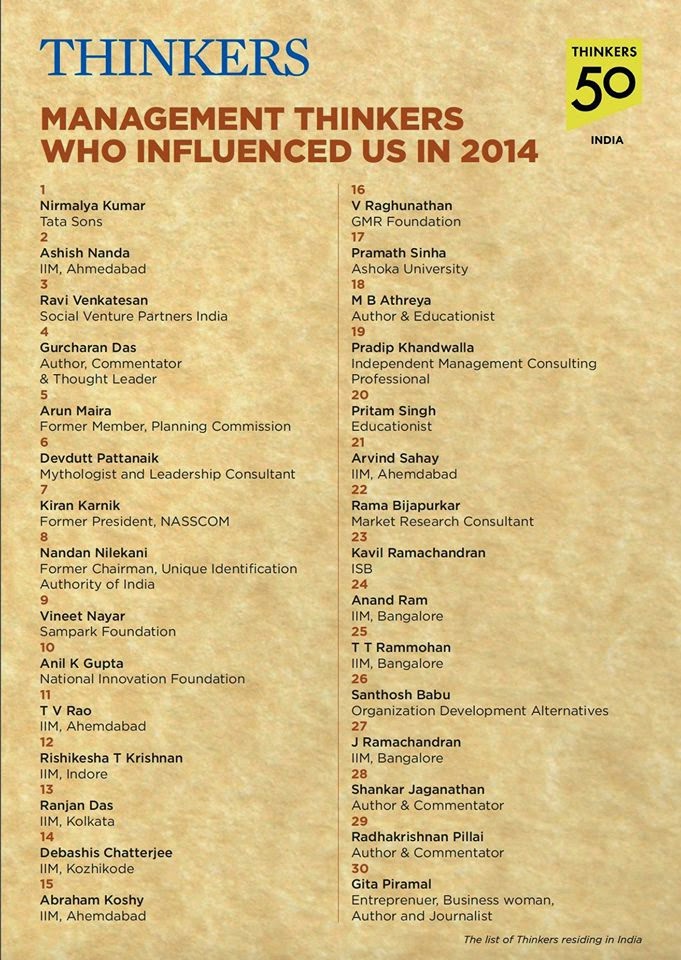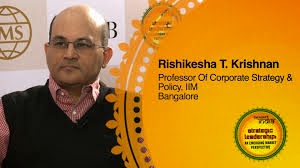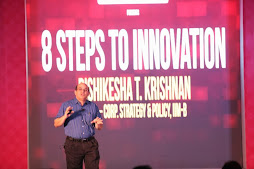Last week, I wrote about the MART conference on innovation
in emerging markets. One session I really liked was on healthcare innovation. Kavita
Narayan who worked earlier with the Hospital Corporation of America but now works
with Public Health Foundation of India (PHFI) moderated the panel energetically
and well. The other panelists were Ranjit Shahani (Novartis), Vikram Damodaran
(GE) and Ravi Kaushik (until recently with GE, now with Baxter).
Some contrasts came through well. A Nobel prize winning
scientist from Sweden is promoting the use of his latest “perfect” catheter. It
costs 20 euros, and works better than any existing one. He wants it to be used
in India. The catch is that a catheter in India costs just one euro –
underlining once again that even healthcare innovation has to be contextual and
appropriate!
In contrast, PHFI has a new swasthya slate that can be taken
to a patient’s door and communicate and store data through a mobile or android
platform. It covers parameters related to key diseases and can be used by
frontline health workers. Not only should this be a good diagnostic tool, it should
ensure data integrity, and collection of relevant data for future
epidemiological studies.
Novartis’ Argoya Parivar
Ranjit Shahani made a couple of interesting points. The
first is that emerging markets should be called converging markets because they
are now too important and central to be called “emerging.” The other one was
about an integrative health project started by Novartis called Arogya Parivar
that has both CSR and business elements to it.
I particularly liked a chart Shahani showed where five
levels on the individual/family income pyramid were linked to 5 different
business approaches for Novartis in descending order of income: (1) a
business-led approach with normal profitability; (2) a business-led approach
with moderate profitability; (3) a shared value social venture; (4) a zero
profit venture like an anti-malaria initiative; and (5) a completely
philanthropic approach at the bottom of the pyramid.
Arogya Parivar today covers 10 states and 42 million people.
Arogya Parivar has now spread to Kenya, Vietnam and Indonesia with appropriate
modifications
A cute insight from Shahani’s talk – he put a non-Indian expat
as head of the Arogya Parivar project based on CK Prahalad’s advice. In his two
years, this energetic Frenchman went to every corner of India. He wasn’t
explicit about this, but the argument seems to be that an Indian would not have
gone deep into the field!
GE Healthcare & Emerging Markets
Vikram Damodaran of GE pointed out that most healthcare revenues
come from 2.5 billion people and the other 4.5 billion people in the world don’t
have access to healthcare or are badly under-served. But emerging markets have rapidly
become an important part of the healthcare business landscape. GE Healthcare is
now an $18B business, and 50% of this business comes from outside the original “triad”
of North America, Western Europe and Japan.
GE’s program to expand its healthcare to non-traditional
areas is now under the banner of Healthyimagination, a program that involves a
$6 Billion commitment. But globalization of GE’s healthcare footprint started
17 years ago with the creation of distribution outposts. The company soon realised
that was not enough. So, they moved towards localization – an example of this
is the 300,000 square feet of supply chain created in Bangalore. But it didn’t
take too long to find that there are limits to the costs that can be squeezed
out through supply chain improvements.
An important milestone in the next phase was the successful “In
China for China” (ICFC) programme that GE ran from 2001-06. Vikram explained
how this was particularly successful in China. As part of the country’s
planning process, each region / town/ village was allotted quotas of medical
equipment in physical terms - e.g. one MR scanner. This was funded by the
government, with no explicit cap on affordability. As a result each geography
tended to buy what he described as the “biggest, meanest” machine. I imagine this
must have suited GE’s product portfolio of large, powerful health equipment.
This program has now been modified as “In Country for Country” to facilitate
transfer to other countries.
Getting innovation right for emerging markets was a learning
process. The interpretation feature in sophisticated scanners was initially
removed from low-end scanners, but the company later realized that this feature
would be more important in low-end scanners as they are often used by relatively
unsophisticated users like General Practitioners.
Vikram expressed the view that India is a dynamic and
entrepreneurial market as far as healthcare is concerned. In the US, an MR
scanner is used for 9-10 cases per day, and a scan costs $1,500. In India, a
scanner is used for 70 cases a day, the per scan cost could therefore be as low
as $150 given the competition between providers. A dynamic market like India
could be the crucible for the next round of healthcare innovation.
The Importance of Training
Kavita asked Vikram a question about the need for training.
Vikram’s answer: put intelligence into the device instead, as in the case of GE’s
new baby warmer where an attendant has only to worry about an alarm ringing or
the ultrasound scan plane coaching assistant that helps a novice locate the
scan plane. The other alternative is partnerships – GE works with an NGO called
Eastmeetswest that oversees device use.
“We must be doing something right”
Ravi Kaushik, now with Baxter, injected an optimistic note
into the discussion by pointing out that India’s Flipkart hit the $1 B mark in
6 years, a shorter time than it took Amazon to reach the same landmark. Hamid
Karzai’s daughter had her baby delivery at Fortis Gurgaon and Karzai was quoted
in the press as trusting the warm healthcare in India. Ravi’s conclusion was
that “We must be doing something right.”
Barriers to healthcare innovation in India
The three panelists had distinctive perspectives on this
question.
Shahani of Novartis had a predictable answer. His number 1
barrier to healthcare innovation in India is the absence of an ecosystem for intellectual
property rights. He pointed out that Novartis has set up its new research
centre for malaria, dengue and TB in Singapore and not in India. He
particularly pinpointed the absence of data protection, leading to a situation
where anyone can use the data generated in clinical trials in India.
Vikram Damodaran underlined the absence of conducive
manufacturing policies. Building devices out of India is often expensive. He
also pointed to a gap in the education system – there is no university that has
both a good engineering school and a medical school working together. (I recall
that IIT Kharagpur wanted to set up a medical school some years ago, but this
got stuck in some bureaucratic and regulatory maze. I wonder what happened to
that plan, and whether it is still on the cards…)
Ravi put his finger on weak academia-industry interaction
and the absence of venture capital and incubators. He asked a provocative
question: Why is all the funding available coming from Omidyar or the Gates foundation?
Why don’t we have funds from India?
When will Universal Healthcare be achieved in India?
Kavita referred to a recent PHFI Universal healthcare
report, and asked whether it can be achieved by 2020? If not by 2030?
Vikram’s view was that the Infant Mortality Rate and the Maternal
Mortality Rate will come down rapidly. Cardiac screening will increase. He felt
that there is a need for a comprehensive patient registry to track diversity of
cancers.
Ravi thought that people put up with problems for years
without taking remedial action Instead, patients have to take more
responsibility for their own health.
Shahani pointed out that in spite of all the controversy
around Glivec, only a very small number of patients in India pay for it while thousands
get it free.
Ayush and Western Medicine
During the course of the healthcare panel, there was an
interesting discussion about Indian traditional and western medicine. The audience
had several adherents of holistic well-being who spoke in favour of ayush
remedies. The usual debate of whether ayush should be subject to the same criteria,
testing/reliability as used for western medicine came up. Vikram advocated
standardization of Ayush even if it is not subject to the same standards of
testing. Apparently, there have been some efforts in this direction in China.
[The summaries of different views here are as I remember
them. I am responsible for any errors in reporting. Any comments on the views
expressed here are the personal observations of the author.]





































